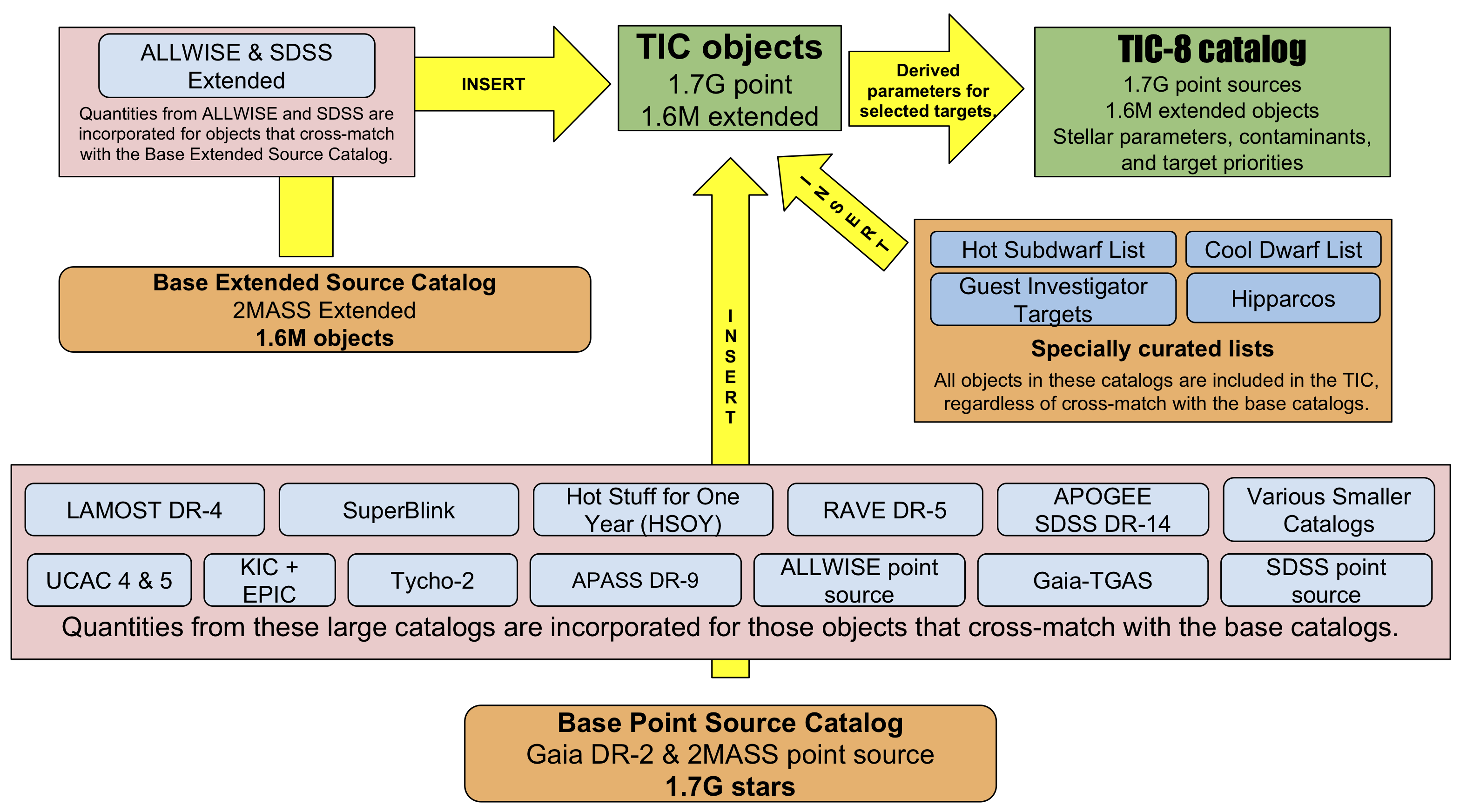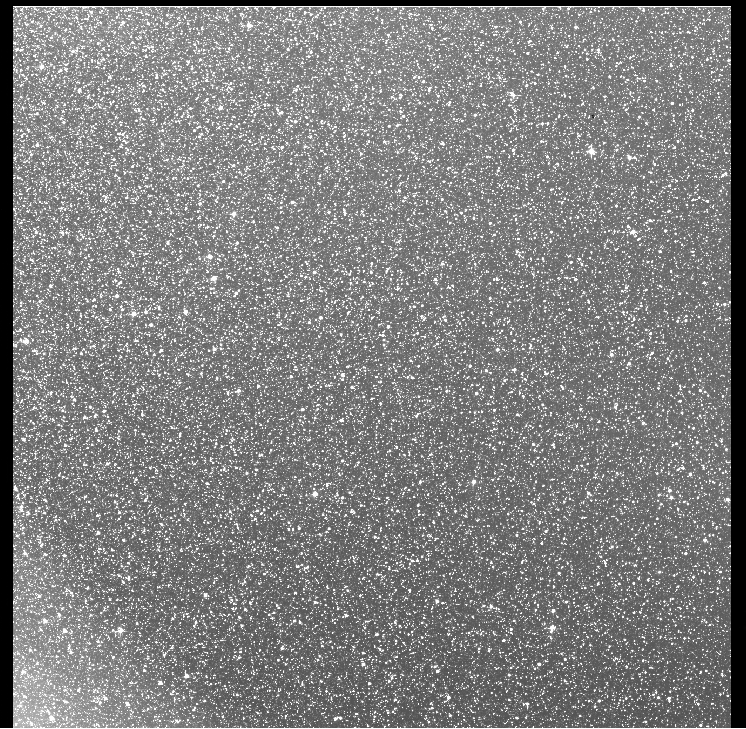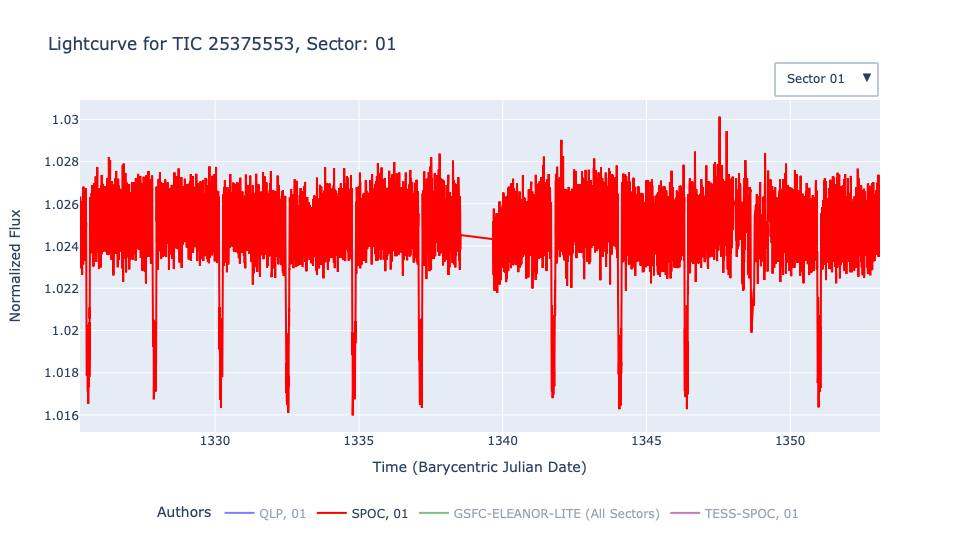The four cameras of TESS take consecutive images of a particular region of the sky every 2 seconds. Several data products are produced by the TESS mission from these images: Full Frame Images (FFIs), Target Pixel Files (TPFs, also known as postage stamps) of selected targets, and corresponding Light Curves (LCs).
Each of these is created on-board the spacecraft by co-adding the individual 2-second exposures. These data products are provided in standard FITS format with multiple extensions which contain additional information on calibration, background removal, cosmic-ray rejection, and in the case of the TPFs aperture masks indicating the pixels used to extract the lightcurve. For more information, see the TESS mission page at MAST, the TESS pipeline, as well as the slideshow presented below.
Types of TESS Data Products
TESS identifies targets from a target list onboard the computer, and selects small pixel cut outs around those regions. The FFIs and pixel cut outs are downlinked. The FFIs are then sent to the MAST archive; the pixel cut outs are processed by SPOC into TPFs, and then LCFS. The process is illustrated below. To learn more about these data product, explore the tabs below.

TESS Input Catalog (TIC)
To meet the goals of the primary mission, an all-sky catalog was generated to act as a basis for target selection. The TESS Target Selection Working Group (TSWG) was tasked with the creation and maintenance of the catalog with the aim of compiling every optically luminous, persistent object in the sky down to the limits of available wide-field photometric catalogs including both point sources and extended sources. This enables the selection of optimal targets to search for small transiting planets and allows flux contamination to be calculated in an optimal aperture for each target (critical due to the 21 arcsec TESS pixels). The resulting "The Revised Tess Input Catalog And Candidate Target List" is the source from which the >200,000 primary mission targets were selected and is known as the TESS Input Catalog (TIC).
The TIC was assembled based on the Gaia DR2 catalog, and augmented with data from many additional catalogs to create a full list of point sources and extended sources that could be observed by TESS. The input catalog data are used to determine the physical and observational parameters of many of the TIC stars, including stellar radius, stellar mass, and effective temperature. TIC-8 includes 1.7 billion point sources and about 100 million extended sources. A visual overview of the input catalogs and methodology used to construct the TIC is shown in the schematic below.

The TIC can be directly accessed through the MAST Portal by first selecting MAST Catalogs as the collection and then TESS Input v8 as the Mission. A full description of the assembly, content, and properties of the TIC can be found in the Stassun et al. (2019) paper.
The Candidate Target List (CTL)
The Candidate Target List (CTL) is a subset of the TIC. This is a set of targets selected as likely good targets for transit detection and consists of two main components. - All TIC stars brighter than TESS magnitude = 13, and an estimated stellar radii smaller than RSun. - All stars included in the curated Cool Dwarf Catalog (CDC) .
The CTL is a list of about 9.5 million stars, each evaluated according to a metric that prioritizes the star for transit detection, which incorporate the TESS magnitude, stellar radius, estimated flux contamination, and number of sectors of observation. You can search the CTL datatabe please at the MAST Portal by selecting MAST Catalogs as the collection and then TESS CTL v8.01 as the Mission. For more information on the TIC and CTL please visit the MIT page.
FFIs are a collection of science and collateral pixels observed simultaneously. A single FFI is the full set of all science and collateral pixels across all CCDs of a given camera. Note that there are 16 CCDs on the spacecraft, each of which is supported by 4 output channels.
FFIs are FITS format files containing all pixels on a single CCD. The FFI data is provided in three types: uncalibrated, calibrated, and uncertainty. The uncalibrated FFI data is provided in one file with two Header/Data Units (HDUs): a primary header and the CCD image header and data. The calibrated FFI data and its uncertainty are provided in a separate file with several HDUs: a primary header, the CCD calibrated image header and data, the CCD uncertainty image header and data, and the cosmic ray corrections binary table header and data. TESS FFI images are generally available ~2 weeks after the end of a sector.
Note that Cosmic Ray Mitigated FFIs are the same as FFIs except they are collected with the onboard cosmic ray mitigation enabled.
The FFIs have observational cadence of 30 minutes (Cycles 1 and 2), 10 minutes (Cycles 3 and 4), and 200 seconds (Cycles 5 and 6).
In addition to the TESS mission pipline-detrended FFIs, TESS Image CAlibrator (TICA) products are now available. These High Level Science Products (HLSPs) were designed as quick-look preview images of TESS FFIs, and are released every half-orbit (~weekly). MAST provides cutouts from the TICA FFIs, as well as the mission FFIs through the TESSCut service.
To learn more about FFIs and how to use them please see this tutorial

The Target Pixel Files are the rawest form of target-specific data available at MAST. For each short-cadence target in an observing sector, TESS only acquires the pixels contained within a predefined mask. These pixels are used to create the data found in the light curve files.Each TPF packages these pixels as a time series of images in a binary FITS table. In this binary table, the pixel values are encoded as images. Each element in the binary table contains the pixels from a single cadence. The purpose of these files is to provide the data necessary to perform photometry on the raw or calibrated data when needed (or desired) to understand (or improve) the automated results of the TESS pipeline.
If a target is observed in more than one sector, multiple TPFs will be created for that target. Note that they may be made available in separate deliveries to the MAST.
The images in the TPF will have dimensions equal to the bounding box of the pixels that were collected for that target. Depending on the location of the target on a CCD, a TPF may therefore contain pixels that do not contain stored data.
TPFs will have several HDUs: a primary header, a binary table of images header and data, the aperture mask image header and data, and the cosmic ray correction binary table header and data. The aperture mask image provided with each TPF file indicates the pixels that were collected for the target and which of those pixels were used for photometry.
To learn more about TPFs and how to use them please see this tutorial

Lightcurves are flux time-series produced for each short-cadenced target (from the TPFs) using Simple Aperture Photometry (SAP). LCs are used to search for transiting planets and other astrophysical phenomena. TESS light curves are FITS format files that contain the output of the photometric extraction and subsequent systematics removal (cotrending) performed by the SPOC algorithms. The flux and respective uncertainties are provided at each cadence, with NaNs filling in any missing data values.
A single Light Curve File contains the data for one target for on observing sector. Identical to the case for TPFs, if a target was observed in more than one TESS sector, multiple Light Curve Files will be created but they may be made available on the MAST in separate deliveries. Light Curve Files will also consist of several HDUs: a primary header, the light curve photometry binary table header and data, and the aperture mask image header and data. The aperture mask image provided with each light curve is the same as that provided with the corresponding target TPF file.
To learn more about LCFs and how to use them please see this tutorial

- TESS-HERMES Spectroscopic Survey (PI: Sanjib Sharma)
- Data Products From TESS Data Alerts (PI: Roland Vanderspek)
- TESS Data For Asteroseismology Lightcurves (PI: Rasmus Handberg)
- Cluster Difference Imaging Photometric Survey (PI: Luke Bouma)
- eleanor FFI Light Curves From TESS (PI: Benjamin Montet)
- A PSF-Based Approach to TESS High Quality Data Of Stellar Clusters (PI: Domenico Nardiello)
- TESS Light Curves From Full Frame Images (PI: Douglas A. Caldwell)
- TESS Lightcurves From The MIT Quick-Look Pipeline (PI: Chelsea X. Huang)
- Multi-Sector Light Curves From TESS Full Frame Imaes (DIAMANTE) (PI: Marco Montalto)
- Convolution Neural Networks for Flare Identification in TESS 2-minute Data (STELLA) (PI: Adina Feinstein)
- TESS Image CAlibrator Full Frame Images (TICA) (PI: Michael Fausnaugh)
- The TESS Stellar Variability Catalog (TESS-SVC) (PI: Tara Fetherolf)
- TESS-Gaia Light Curve ("TGLC") (PI: Timothy D. Brandt)
- TESS Eclipsing Binaries ("TESS-EBs") (PI: Andrej Prsa)
- TESS FFI-Based Light Curves from the GSFC Team (GSFC-ELEANOR-LITE) (PI: Brian P. Powell)
- Simulated TESS Light Curves for Measuring Rotation with Deep Learning ("SMARTS") (PI: Zachary R. Claytor)
- Cutouts from Wide-area TESS Coadded Images ("TESS-COADD-CUTOUTS") (PI: G. Bruce Berriman)
Co-trending basis vectors (CBVs) represent the set of systematic trends present in the ensemble flux data. CBVs are provided for each operational sector of the mission.
CBVs are calcualted by the TESS pipeline from a Principle Component Analysis and used to mitigate systematic artifacts within the target light curves. CBVs can be utilized for manual photometric correction more tailored towards the user's science. To learn more about CBVs and how to use them, check out this tutorial.
Additional data products include focal plane characterization files, engineering output, and telemetry data used to calibrate the images and determine the status of the spacecraft. A sample of these data products is displyed below, but for a full list of available products, see the holdings at the MAST.
Collateral data includes pixels from leading and trailing virtual columns, leading and trailing masked rows, and trailing virtual rows (in units of ADC counts).
Additional collateral data includes auxiliary instrument models which describe the calibration effects.
Pixel calibration is performed on both the cadence pixels and Full Frame Image (FFI) pixels, and calibrated science pixel values, in photoelectrons, along with their uncertainties are archived at the MAST.

During the development of a space mission, several End-to-End tests are conducted, which include testing the pipeline and the data transfer between different institutions. To do this various data products are simulated, these data can be very useful to the community, and aid potential TESS users in the development of tools and in assessing the feasibility of an investigation.
Data for the "End-To-End 6" can be found here.
The Mikulski Archive for Space Telescopes (MAST)
The official archive for TESS mission data products is the Mikulski Archive for Space Telescopes (MAST) which is hosted at the Space Telescope Science Institute (STScI). MAST has created a Summary page with information on data access, tools, and resources for TESS data. Brief descriptions are provided below,MAST API/astroquery
This allows the user to search for, and retrieve, TESS data products programmatically based on a list of coordinates or target names, interact with observational data, TIC, and CTL catalogs in custom programs.
exo.MAST
Here you can find MAST data (including TESS) for known planets and TOIs, matched to orbital phase. You can also plot sector-stitched Data Validation light curves, as well as access exoplanet parameters with references.
ExoFOP-TESS
ExoFOP-TESS optimizes resources and facilitates collaboration in follow-up studies of targets observed by TESS. The portal provides stellar parameters from the TESS Input Catalog (TIC), which is served by the MAST archive, and planet parameters from the NASA Exoplanet Archive.
TESSCut
TESSCut allows the user to create custom time series pixel cutouts from the TESS full frame images and find out what sectors / cameras / detectors a target was observed in. Further information about TESSCut can be found here.
Bulk downloads
Here, you can:
Archive manual
The manual provides step-by-step instructions on how to:
Data products at MAST
The following TESS data products and catalogs are currently available at MAST: